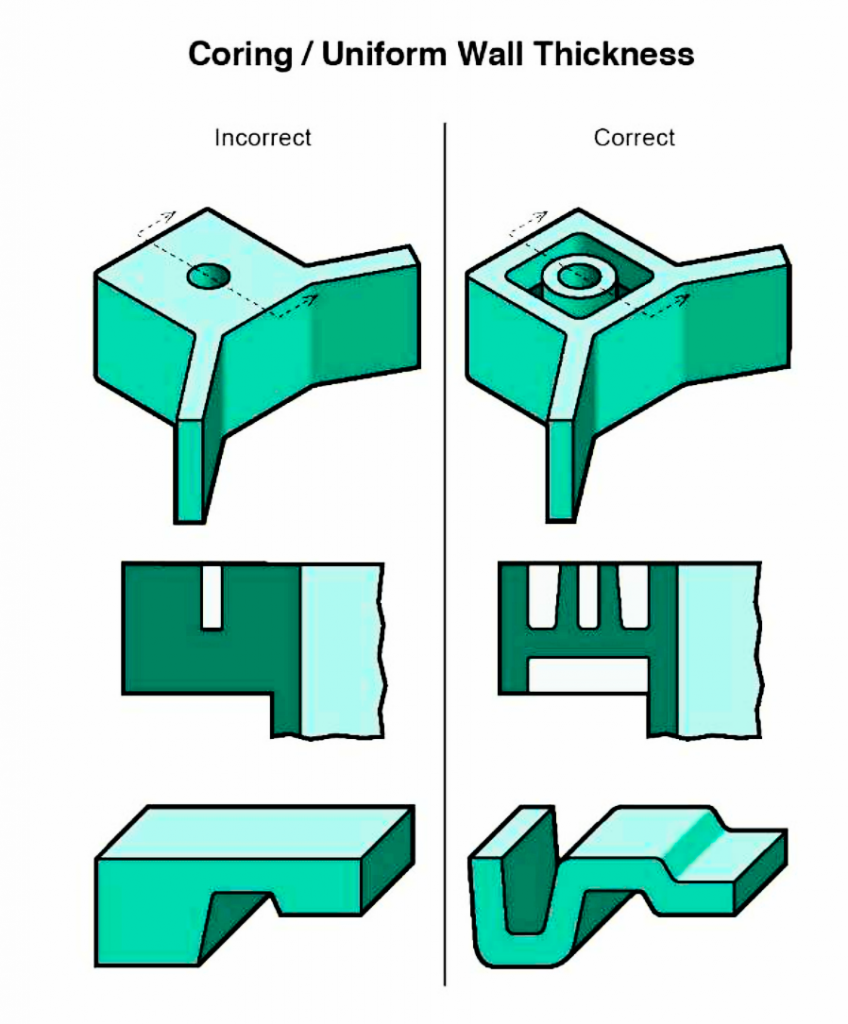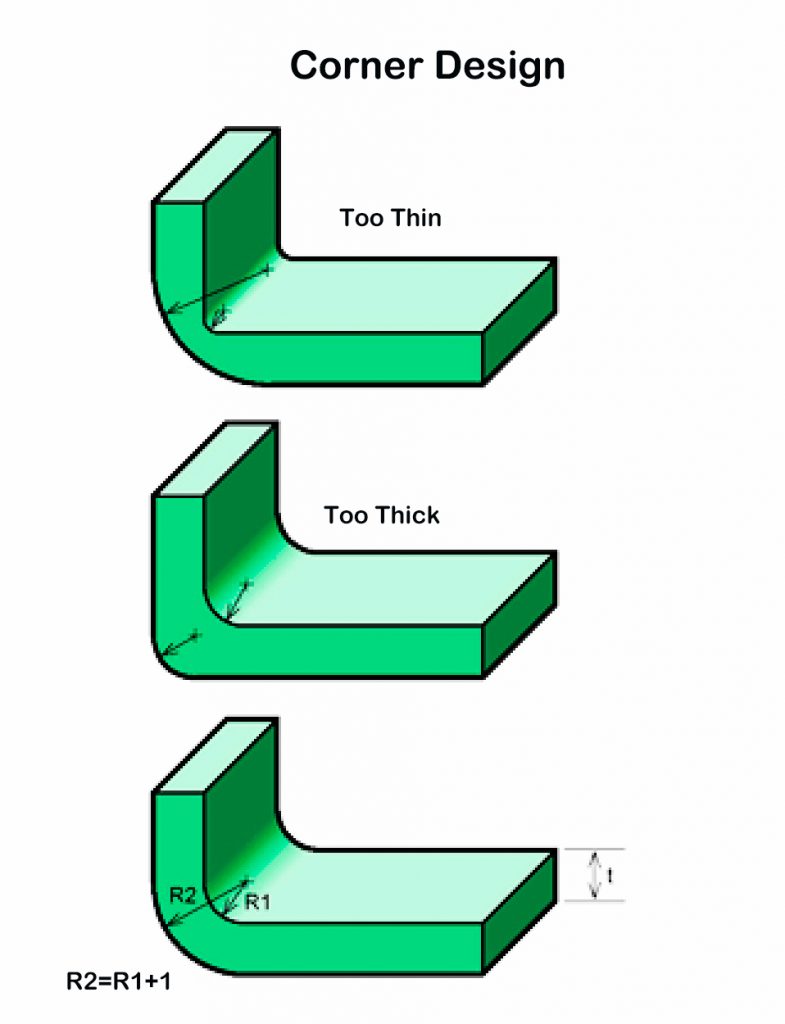Designing parts for injection molding requires careful planning to ensure quality, efficiency, and cost-effectiveness. This article provides a comprehensive guide to essential injection molding design principles, covering critical aspects like wall thickness, draft angles, corner radii, and material selection. By adhering to the design guidelines, engineers can avoid common defects, streamline production, and achieve consistent results.
Injection molding is one of the most widely used manufacturing processes for creating complex and precise plastic components. Whether you’re designing parts for automotive, consumer electronics, or medical applications, adhering to proper design guidelines ensures higher-quality results, cost-effectiveness, and efficiency in production.
This article explores essential design guidelines for injection molding, helping engineers and product designers create parts optimized for manufacturability and performance.
1.Wall Thickness: Consistency is Key
Maintaining uniform wall thickness is fundamental in injection molding. Inconsistent thickness can lead to defects such as sink marks, warping, or uneven cooling.
- Recommendation: Keep wall thickness as consistent as possible, ideally within 2-4mm for most plastics.
- Why it matters: Uniform walls allow plastic to flow evenly during molding, minimizing stress and shrinkage variations.
If thickness changes are necessary, use gradual transitions to avoid abrupt changes that could cause weak points or flow hesitations.
2.Draft Angles for Easy Ejection
Draft angles are essential for the smooth ejection of parts from the mold. Without adequate draft, parts may stick to the mold, causing surface damage or delays.
- Recommended draft angles: At least 1° per side, increasing for deeper or more textured parts.
- Pro tip: For highly detailed or textured surfaces, use draft angles of 3° or more to ensure trouble-free ejection.
3.Ribs and Bosses: Reinforcement Without Bulk
Ribs and bosses provide structural strength to parts without significantly increasing material use or weight. However, improper design can lead to sink marks or voids.
- Ribs: Limit thickness to 50-60% of the adjacent wall thickness. This avoids excessive shrinkage.
- Bosses: Base diameter should be 2-3 times the wall thickness, with fillets at the base for added strength.
4.Gate Design and Placement
Gates are entry points for molten plastic into the mold cavity. Proper gate design and placement ensure even filling and reduce defects like weld lines and voids.
- Gate placement: Locate gates in thicker sections of the part to allow proper material flow.
- Types of gates: Depending on part geometry, you can choose from common gate types like edge gates, tunnel gates, or hot runners.
5.Avoiding Undercuts
Undercuts are features that interfere with the mold’s opening and closing action. While they can add complexity to the design, undercuts often require side actions or inserts, increasing tooling costs.
- Solutions: Redesign the part to eliminate undercuts, or use lifters and sliders if absolutely necessary.
- Alternative features: Use snap-fits or other design strategies to achieve functional goals without undercuts.
6.Corner Radii to Reduce Stress Concentration
Sharp corners in injection-molded parts often lead to stress concentration, increasing the risk of cracking or failure. Adding fillets to corners distributes stress more evenly and improves mold filling.
- Internal corners: Use a minimum radius of 0.5 times the wall thickness.
- External corners: Ensure radii are not too sharp to avoid fragile edges.
7.Material Selection: Tailored for the Application
Selecting the right material affects the performance, aesthetics, and manufacturability of your part. Common considerations include:
- Strength and durability: For high-stress applications, materials like ABS, polycarbonate, or nylon are preferred.
- Chemical resistance: Use materials like HDPE or polypropylene for chemical exposure.
- Clarity: Opt for polycarbonate or acrylic for transparent parts.
Consult material datasheets and suppliers to ensure your selection aligns with project requirements.
8.Surface Finishes and Textures
Surface finishes impact the appearance, functionality, and mold release of injection-molded parts.
- Glossy finishes: Use polished molds for shiny, smooth surfaces.
- Matte or textured finishes: Consider sandblasted molds for a non-reflective or tactile feel.
Ensure the chosen finish doesn’t interfere with mold ejection or part fitment.
9.Tolerances and Precision
Injection molding can achieve tight tolerances, but excessive demands may drive up costs or cause defects. Define tolerances based on functional needs and avoid over-specifying.
- General tolerances: ±0.1mm for most features.
- Critical dimensions: Work closely with the mold maker to ensure feasibility
10.Mold Flow Analysis: Testing Before Manufacturing
Mold flow analysis is a simulation tool used to predict the flow of molten plastic within the mold. It helps identify potential issues like air traps, weld lines, or filling imbalances before production.
- Benefits: Optimizes gate placement, reduces trial-and-error, and ensures parts meet quality standards.
- When to use: For complex geometries or high-volume production, always perform a mold flow analysis.
11.Incorporating Assembly Features
Designing parts for ease of assembly can save time and reduce costs in multi-component products. Consider:
- Snap-fits: Allow for tool-less assembly.
- Interlocking features: Use tabs or slots for alignment.
- Weld lines: Design with ultrasonic or adhesive bonding in mind.
12.Cost Considerations: Balancing Design and Efficiency
Every design choice impacts production cost, from tooling complexity to cycle time. To maintain cost-efficiency:
- Simplify geometry: Minimize unnecessary features or undercuts.
- Optimize part orientation: Reduce material usage and maximize cavity space.
- Choose standard materials: Avoid custom formulations unless essential.
Conclusion
Designing for injection molding is a balancing act between functionality, manufacturability, and cost. By following the guidelines outlined in this article—such as maintaining consistent wall thickness, incorporating draft angles, optimizing gate placement, and selecting the right materials—you can ensure that your parts meet quality standards while minimizing production challenges.
Each design choice impacts the final product, so it’s essential to prioritize collaboration with experienced manufacturers and leverage tools like mold flow analysis for precision and efficiency.
At RAPIDMFG, we specialize in delivering high-quality injection molding solutions tailored to your needs. With expertise in rapid tooling, low-volume production, and advanced manufacturing techniques, we help clients achieve optimal results with minimal lead times. Our commitment to excellence ensures every part meets your exact specifications, from design to production.
Discover how RAPIDMFG can bring your ideas to life by visiting our website or contacting our team today.


